This article discusses the beauty and the magic of marbles, noting their popularity, their uses, the materials they are made from, and where collectors can find them. It originally appeared in the July 1942 issue of American Collector magazine, a publication which ran from 1933-1948 and served antique collectors and dealers.
There is amusement for children of nearly all ages in such elemental manifestations as quick motions, bright colors, symmetry of form, smoothness and clashing of sounds. All these are supplied by marbles and it is quite natural, therefore, that they should have become almost universally adopted as one of the playthings of childhood.

A Porringer Full of Marbles: In this group they are of glass and show many varieties of decoration achieved by swirling the interior colored threads. At the extreme right is one with a sulphide center in the shape of an animal.
We must not lose sight of the undeniable fact that the latter runs right on through youth, adolescence and into full maturity.
Consequently we might expect, as we do find, that marbles are an enjoyment through the entire age period — a toy for the nursery, dice for the “sidewalk and alley craps” — of early boyhood, articles for rival games in the sports of youth and manhood, and finally collectors items.
In one form or another they have served their purpose from the early ages of man. Crude at first, they gradually underwent evolutionary improvements down through time until they reached a perfection that is now a gratification to those who collect and admire these exquisite examples of craftsmanship of bygone days. To all who love the intriguing beauty and charm of the simple but intricate old-time workmanship, I want to urge that the acquiring and possessing of antique marbles is a joy in itself and well-nigh irresistible.
Most of them have lost their luster of newness and many of them bear blemishes, betraying their years of service in childhood’s play. Chipped spots where pieces have been broken out and gone are common. Some of these are large and deep, but mostly they are small nicks scattered over the surface.
Some of the old glass ones have little roundish fractures showing more or less concentric silver-like rings or frosted areas with the flake-like pieces of glass still intact. These spots are known as “moons.”
All of the old glass marbles will show a tarnished luster and a multitude of scratches and abrasions over the surface when examined with a magnifying glass. This is the same as will be found with any old glass that has had the wear of time.
Some marbles have an irregular, wavy surface due to lack of good workmanship in their finish. All of these various marks or imperfections may be removed and the loss of polish restored, if one so wishes, by any good repairer of glass and then they will look even as new. For study and understanding of them, this is entirely unimportant, but if one prides one’s collection it is desirable.

Glass Marbles of Various Designs: Those of swirled design predominated. Some are opaque or translucent, but with most of these clear glass was used for the casing. At the right of the tankard is a large marble with a sulphide figure of a boar in the center.
Romance is truly evident in old marbles. They were spontaneously created by the ingenuity of a remote and simpler day, a day when men knew less of strife in the hurrying world of mechanical competition than is now known. Also a day in which devotion to purpose and pride of accomplishment were the governing influences for the artisan who so dexterously formed these marbles.
Through the years, such marbles have been the joy of children who fondled them and treasured their beauty and possession. They have incited mirth and altercation, have been lost and found, have been stowed and retrieved, have been passed on from one child to another and perhaps from family to family and then at the end of it all some of them have reached that great open road of the unneeded to become the intimate examples and welcome companions of those collectors who love the sentiment and beauty of the unreturnable past.
Of the old marbles now available for collection, those made of stone are perhaps the most naturalistic and simple. The examples that have come under my observation range from medium in size to small. For the most part they are smooth and symmetrical in form. The color varies from shades of brown. Some show attractive mottlings with darker splotches. Such marbles are not numerous, but are of real interest to the collector and should not be passed by.
Then there are marbles made of clay molded into shape and dried or baked. Some of them are plain; other were decorated with stripes and designs in color. They were sometimes glazed, but most of them lacked such luster. As found today they often show scaling and flaking of their surfaces, indicating that they are comparatively fragile. They are lighter in weight than those of stone and have a greater rebound when dropped onto a hard surface.
I am always confronted with skepticism as to the age of these marbles, for they were made in this country for many years and have sufficient signs of use to warrant their inclusion in the antique.
Without a record I could never feel assured that any one of the clay marbles was particularly old; doubtless some of them may be real antiques, yet what ones I would not venture to designate.
Then there are marbles made of pottery. They were nearly all irregular in form, rarely showing exact roundness or smoothness. Often little “eyes,” from one to three in number, can be observed on the surface. These “eyes” were probably in some way connected with their support in going through firing. Mostly these little spots lack the general coloring of the marble, but are surrounded by a ring darker of shade.
All are glazed and have a variety of colors — white or white with cloudings, to rather solid colors in blue, green and brown, often with mottlings of deeper shades. Frequently there is surface roughness due to adherent grains of sand. This suggests the rather careless manner in which these marbles were made. But they are firm and strong and do not as a rule show mars of accident. They vary in size from the very small to the moderately large. They are more frequently found than the stone marbles, but less common than those molded from clay.

Typical Marbles That Collectors Seek: Upper row at the left, three large and two small ones of pottery; in the center, three glass shooters and small ones of clay; and right, a large glass one with sulphide center in shape of an eagle with four of clay with colored stripes. Lower row, left to right, three with sulphide centers, two of enamels and one of a fish. In front of them, one of slag glass. Next, one with opaque and irregularly swirled center. To the right and in center of this, a marble of amber glass with embedded metallic flecks. At the extreme right, two sizes of clear glass marbles with swirled center of colored threads. The technique employed in making these was approximately that used in paperweights of similar decorative design.
Then there are marbles made from agate. Their firmness and texture suggest glass in various veins and strata of colors, but they contain no air bubbles, which at once identifies them as not being made of glass, because essentially all old glass marbles do contain air bubbles. They are desirable to possess in a collection, but in my experience are rare to obtain. And finally there is that lovely group of marbles — the ones so inspiring to the collector. They are fabricated principally after five general designs:
(1) those with the interiors showing spinnings and swirls of colors and surrounded by an encasement of clear crystal glass; (2) those whose centers are a replica of animals, birds, fish, people, objects, numbers, and so forth, that were, made in a somewhat silverish white color and thickly surrounded by clear crystal glass; (3) those with solid opaque centers splashed or marked on the surface with colors, often several, and surrounded with a medium thickness of clear glass; (4) those that are of solid amber, blue, green or sometimes clear glass containing flecks of gold, silver or white scattered throughout their substance, and (5) those marbles where the glass was opaque or consisted of a blending of subdued colors, mostly the shades of brown and sometimes showing spots that are “china-white.” This last group are called by collectors of slag marbles.
The plain glass used in old marbles was not always of crystal-white clarity, but showed a tinting with some color — blue, green and yellow being the most frequent ones observed,
In addition to air bubbles in the old glass marbles, sometimes there is a “crackled glass” appearance. There is much in workmanship of old-fashioned marbles that indicates the mood aid the genius of those who made them, but there is not much that suggests idealistic perfection in their fabrication, for they are somewhat primitive and crude in design and finish, when judged by the higher standards of master craftsmanship. Yet they are nonetheless fascinating and perhaps are to be the more cherished, for they depict the output of hands and minds in a pioneering day. After all, they were made as playthings.
The old glass marbles with the swirls are, for the most part, more finely designed and executed than those containing silvery white or sulphited design encased in the clear glass. It is exceptional to find exact duplicates of any of these glass marbles. I have never seen such an occurrence in the ones with the swirled centers, their bright colors of blue, red, purple, green and yellow, and less frequently others are always arranged in different combinations or different spinnings, but the ones with silvered white centers do offer duplicates.
The figures in the latter were mostly built upon a base with a flat bottom, as though they were intended to be in a sitting position. This may have been necessary in their construction, but more likely it was a feature of design. These central opaque objects were probably mold-made and subsequently surrounded or “cased” by clear glass.
Some of them show very good symmetry and detail, but in general they lack evidences of good workmanship. In many air bubbles adhere to decorative design, which make a distorted appearance. But in spite of crudeness and lack of refinement, they are most enticing to the collector. While all these old glass marbles seem like inventions of fairyland and a joy to behold, naturally there will be individual preferences and mine is for the glass ones with swirled interiors. Collecting of antique marbles is a pastime of real fascination to one who loves antiques.
They are seldom found in homes or procured from such sources, but the dealers now and then obtain them from individuals who offer their possessions for sale. It is from these dealers that we have the best opportunity for acquiring additions to our collections. And what genuine humanitarians are these dealers who assemble and distribute such antiques. How well they understand the needs and choices of the collector. How spontaneously and devotedly and with what congeniality they serve such needs! They will unstintingly assist in so far as they can in securing and giving reminiscences of history and lore connected with whatever they are supplying. They will help in all the ways at hand in procuring some particular object coveted by the collector, and mostly with a willingness not overshadowed by thought of remuneration. Moreover they possess a scholarly knowledge of their chosen vocation. The wares they handle thereby have a greater certainty of authenticity and reliability.
Quite naturally we may inquire whence came these toys that a half century and more ago were so commonly found in the homes throughout the United States. If we investigate carefully we shall find that they were chiefly if not entirely made in Germany and then brought over here as articles of trade. There are no available records to prove that they were ever made in this country, yet there is a division of opinions relative to the probability of some of them having been of American make.

The Chief Varieties of Old American Marbles: Upper row, group 1, glazed pottery marbles; group 2, small stone marbles; and group 3, typical ones of clay with striped colored decoration. Lower row, group A-1, four glass examples with sulphide centers in the form of animals; A-2, a marble made of slag glass; A-3, two of pottery with colorful glazed decoration, one mottled, the other in a swirled effect simulating those of glass; A-4, one of amber glass flacked with gold; and A-5, three large marbles of clear glass where decoration was accomplished by spiral twisting of threads of colored glass in the process of manufacture.
I am assured by collectors who are in a position to know much about the manufacture of old glass that quite likely many of these marbles were made in this country. Others frankly deny this and say they were never made here, but always imported. It seems to be accepted by all, however, where an opinion has been expressed, that they were hand-made and mold-formed. Many glass factories that were operating in this country could likely have made such marbles, even if they did not.
A high authority on old American glass tells me of decanters and water glasses with the busts of eminent personages included in their structure and similar in appearance to the silvery white figures in the old glass marbles. Bakewell Pears & Co., Pittsburgh, made many such pieces of glass. From this similarity one might presume, therefore, that this company could have made marbles with the silvery white or sulphide figures in glass, although my informant has never discovered any records of this or any of the other early American glass, factories to prove that they made such marbles.
It is possible that some of the figures inside the clear glass marbles may have been made by an Englishman — Apsley Pallet. He called his invention “Crystallo — Ceramie” and published a book shortly before the middle of the 19th Century entitled, Curiosities of Glass Making.
He made silvered figures of pottery clay and super silicate of potash, which enabled them to withstand higher heat than that of the glass in which they were encased. His technique was used for portrait cameos, medallions, and the like, especially paperweights. It is said that this was copied by glass workers in Germany, France, England, and quite likely by some of those in the United States. Consequently it may be presumed that the use of these figures in marbles may have had their origin with Pallet or those who adopted his process.
By one of the foremost technical institutions in the East, and authoritative on historic glass of Massachusetts, a belief is expressed that the Boston and Sandwich Glass Company make marbles, for in excavations at the site a considerable number of them, were found, but mostly imperfect or broken. It is intimated that these marbles may have been importations. Yet this is thought to be unlikely and that such marbles were actually made at Sandwich seems more probable. It’ is presumed, however, that the colored canes from which these swirled marbles were molded were importations, for a large number of them have been found in at Sandwich.
This article originally appeared in American Collector magazine, a publication which ran from 1933-1948 and served antique collectors and dealers.

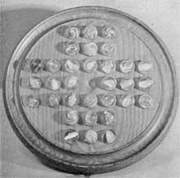 Marbles Among the Earliest Games
Marbles Among the Earliest Games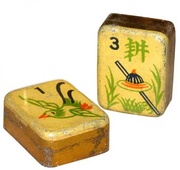
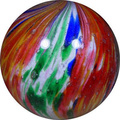 Agates, Corkscrews, and Onionskins: Fun with Antique Marbles
Agates, Corkscrews, and Onionskins: Fun with Antique Marbles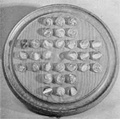 Marbles Among the Earliest Games
Marbles Among the Earliest Games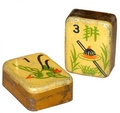 Antique Mahjong Sets: An Antidote to Our Antisocial Internet Society
Antique Mahjong Sets: An Antidote to Our Antisocial Internet Society MarblesAntique glass marbles are highly collectible, from handmade examples by Ger…
MarblesAntique glass marbles are highly collectible, from handmade examples by Ger… Mari Tepper: Laying it on the Line
Mari Tepper: Laying it on the Line Nice Ice: Valerie Hammond on the Genteel Charm of Vintage Canadian Costume Jewelry
Nice Ice: Valerie Hammond on the Genteel Charm of Vintage Canadian Costume Jewelry How Jim Heimann Got Crazy for California Architecture
How Jim Heimann Got Crazy for California Architecture Modernist Man: Jock Peters May Be the Most Influential Architect You've Never Heard Of
Modernist Man: Jock Peters May Be the Most Influential Architect You've Never Heard Of Meet Cute: Were Kokeshi Dolls the Models for Hello Kitty, Pokemon, and Be@rbrick?
Meet Cute: Were Kokeshi Dolls the Models for Hello Kitty, Pokemon, and Be@rbrick? When the King of Comedy Posters Set His Surreal Sights on the World of Rock 'n' Roll
When the King of Comedy Posters Set His Surreal Sights on the World of Rock 'n' Roll How One Artist Makes New Art From Old Coloring Books and Found Photos
How One Artist Makes New Art From Old Coloring Books and Found Photos Say Cheese! How Bad Photography Has Changed Our Definition of Good Pictures
Say Cheese! How Bad Photography Has Changed Our Definition of Good Pictures Middle Earthenware: One Family's Quest to Reclaim Its Place in British Pottery History
Middle Earthenware: One Family's Quest to Reclaim Its Place in British Pottery History Fancy Fowl: How an Evil Sea Captain and a Beloved Queen Made the World Crave KFC
Fancy Fowl: How an Evil Sea Captain and a Beloved Queen Made the World Crave KFC
I’m wondering who I could take old marbles to for a complete inspection, explanation and estimated worth. We have inherited over 100 antique marbles and would like to have information on them. We live in Oklahoma. Thanks for your assistance.
I am also wondering where I can go to find out what the marbles I have are worth. I have over a hundred of them from the 1960’s when I was a child. All glass, from 1 very large one to tiger eyes to very small ones.
Thank you for any help,
Michael
Sometimes you can find local marble stores who will appraise your collection. There are also sites like Marble Connection where folks will help you identify them by photos you post. They won’t venture into value, but you can find out what they are and that will help.
Here is another great site…..
http://web.archive.org/web/20070416064313/www.marblealan.com/my.htm
Good luck
Wow wow wow wow wow — nice piece of history.
There’s a marble collectors’ show in Tulsa next month. Here is some info on the show and also some links to some very informative collector’s forums. Most collectors love to see pictures and help identify marbles. A marble show is a great place to get information on collections.
Tulsa Oklahoma Marble Show:
June 27 2009
Embassy Suites …. 1 800 EMBASSY or 1 918 622 4000 (Ask for the marble show rate) tables $25
For Show information: Cliff (918) 341-8310 or Randy (918) 838-0307
http://www.westvirginiamarblecollectorsclub.com/
http://www.landofmarbles.com/phpbb/index.php
http://marvelousmibs.s4.bizhat.com/marvelousmibs.html
I have two coffee cans full of antique marbles from the 40, 50 or 60’s. I would like to know where I can take them to find out value on these marbles. I live in Central Oregon.
Thanks
I have what looks like to be several clay,or crock marbels.They are light brown in color and have small specks in them a little darker than the light brown.There about 3/8″- 1/2″ in diamiter.I wondered if anyone eles had seen something like this and could maybe tell me around how old it might be.And maybe what they have sold for befor?
I have many marbles that date back to the early 1900s. Clay,ceramic,glass
etc. I would like to find out their value. Can you help?
i have alot of civil war era marbles does anybody know how they got the stars and color in them i gave a class and could not answer this question
aqbout the marbles thanks for any info
found 2 marbles cant find any info on them they are not glass about 10mm in size one is painted red the other is light tan with a picture of a fish kind of looks like an indian drawing its out lined in black but colored in red .has additional blue green markings on other side they are round and smooth but are not completely round they have wore down spots. i live in mississippi 3 miles from nathez trace parkway can anyone tell me what i have found . they look similar to clay marbles.
I live in Sandwich, Massachusetts on Cape Cod. Where can I take my marbles to see if they are old?
I have a half gallon jar over half full of small,med. and large stone marbles and a pint har of med. and large old marbles.
Where can i go in my area to find out the value? Houston , Ms. 38851. My husband has 2 indian stone pipes ,ans ax and other indian artifact. Betty Clark
For all of you who are wondering about the value of your marbles, I would suggest eBay as the first place to start. You can look through thousands of past and current listings of antique, vintage, and modern marbles (clay, hand-blown glass, machine-made glass, etc). After that, you’ll have a better idea of what you have.
Hope this helps!
My dad grew up impoverished in Kentucky during the 20’s/30’s. They made their own marbles from roundish river rocks. They would find a rapid part of the river and ‘build’ their own water operated rock polisher. I have his large, I think it’s called an ‘aggie’? Of course it is priceless to me, but does it have any monetary value?
I’m a bottledigger and Every single time I return from a dump dig, I come back with marbles…different sizes and colors. I have always thought the regularity of finding them to be odd. I must say though that i feel satisfaction in believing that I have rescued these little gems from being forgotten and buried forever.£:•)
Found a stone marble at a rock house ruin on my ranch the other day. High plains of New Mexico on Jose Perea land grant. Find arrowheads all the time but would like to know more about this marble.
My husband has dug up 6 stone, shooter size marbles in our yard. They vary slightly in size and shape. Wwondering what they could be. They’re white
We have 8, looks like old ceramic or porcelain marbles. They have different designs that looks like they were hand painted. I have pulled up all marbles through Google. Have not found these yet